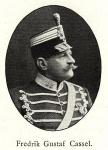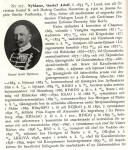-
Posts
432 -
Joined
-
Last visited
-
Days Won
1
Content Type
Profiles
Forums
Blogs
Gallery
Events
Store
Everything posted by GRA
-
The collar dogs looks a lot like Czechoslovak 1st republic mountain troops (see link: http://en.valka.cz/viewtopic.php/t/28791), but I'm not sure about the rest of the uniform. /Jonas
-
-

NATO Non-article 5 BALKANS medal
GRA replied to Ostfront's topic in Rest of the World: Militaria & History
I think Peter means one of these. Just remove your ribbons from the single slides and put them on a 2X-slide instead. /Jonas -
It's not surprising in any way, all these officers were on one form of "fast track" or the other. Most of them served with units in the Stockholm area - close to the court and also the first stop for any foreign military visit (always in need of orderly officers during the visit). Some of them were groomed for higher positions and had prosperous careers ending as generals. Gustaf Adolf Nyblaeus got his Russian decoration as an orderly officer to Prince Eugen during the funeral of Czar Alexander II. In that particular case Nyblaeus was probably chosen to be Prince Eugen's orderly officer five years before the St Petersburg visit because they served in the same regiment. Nyblaeus also seemed to have a Prussian connection, furthermore he served as an orderly officer during maneuvres in Scania in 1889, a year after he was decorated by both Bavaria and Austria-Hungary! One contemporary of Nyblaeus - Fredrik Gustaf Cassel - served much of his career in the same regiment as Nyblaeus (Kungl Livregementets husarer), became colonel and CO (Kungl Smålands husarregemente) a couple of years before Nyblaeus, but still only received the RSO (Knight of the Order of the Sword). An officer being awarded the RSO after some 20 years of service (at the rank of captain) and then nothing more wasn't uncommon. /Jonas
-
Christer, I had some scans from Kungl Livregementets till häst historia (1922) on G A Nyblaeus... /Jonas
-
Hello Christer! The two hussars with the dark blue collars are definitely from Kronprinsens husarer, the regiment was garrisoned in Malmö from 1897, which fits the location of the photo studio. The other two, well, Skånska husarregementet is most probably correct for the one on the right, it fits with the geographic location too - norra Skåne, or North Scania in English. K1 was the designation for Livgardet till häst, its hussar days were short and in the late 18th Century (Livhusarregementet, 1793-97), so that trooper is not from that regiment! (It did however receive a squadron from Kronprinsens husarer in 1897, but whether they kept their hussar uniforms or not, I do not know.) But... Skånska husarregementet had two squadrons garrisoned in Uppsala from 1908, so if the collar of the third trooper is pale blue... It fits reasonably well with the photo studio in Stockholm too as well as providing a more narrow time frame as to when the photo was made. I think we can assume that we're not dealing with a trooper from Livregementets husarer (white collar, silver embroidery), but Smålands husarregemente is however a possibility (yellow collar, gold embroidery). /Jonas
-

VICTORIA CROSS 'MYSTERY'
GRA replied to Mervyn Mitton's topic in Great Britain: Orders, Gallantry, Campaign Medals
You have some good and valid points there James, but keep in mind that those Scottish mercenaries (as they were) in Swedish service during the 17th-18th centuries that settled in Sweden were mostly (if not all of them) younger sons of Scottish noblemen being in time rewarded with land and titles for their service, thus becoming Swedish noblemen. Peter Brown seem to originate from more humble origins than those families you mention, and I personally don't think that too many former Scottish privates of the armies of Gustavus Adolphus settled down in Sweden and managed to keep their family name unchanged for 200 years. There's of course a possibility that Peter Browns parents (or at least his father) were of British ancestry moving to Sweden to make a living, but until proven wrong my gut feeling is that Peter Brown was not the son of a merchant (or from the equivalent level of society), but from the working class or of farmer origin. /Jonas -

Wearing an MID
GRA replied to Mervyn Mitton's topic in Great Britain: Orders, Gallantry, Campaign Medals
I have to agree with both Greg and Rayjin. MiD is worn on the campaign ribbon, but before any campaign medal is issued, then on the tunic. In this case the BWM was considered the campaign medal of WWII, thus no MiD worn on the stars earned during WWII (1939-45 Star, Italy Star and whatever more in this case). /Jonas -
Here's a start: http://web.archive.o.../inf/005RRF.htm There's also some very knowledgeable members of the forum, some (if not all?) of them will have posted in this thread: http://gmic.co.uk/in...land-fusiliers/ I hope you find the information you seek, and please do post pictures of the resulting 1/6th scale figures! /Jonas
-
At ~130 pages in total, you'll only find a handful pages on the early stages of the war, but if the 20th Hussars are "your" regiment there's no other book like it to my knowledge. Expect to pay ~£15 + post & packing for a paperback copy. "The Ramnuggur Boys - 14th/20th King's Hussars 1715-1992" by John Pharo-Tomlin could also be of interest for you. The Marquess of Anglesey's "A History of the British Cavalry" (1816-1939) in general, and volumes 4 (Boer War), 7 (Western Front 1914) and 8 (Western Front 1915-1918) in particular if you want "the whole story". If you want more on the 5th Cavalry Brigade and its units, "History of the Royal Scots Greys 1914-19" and "The 12th Royal Lancers in France" will provide information on the regiments fighting alongside the 20th Hussars during the Great War, as well as supplementing the abovementioned books. /Jonas
-

Netherlands Netherlands paratrooper badge
GRA replied to dedehansen's topic in Northern European & Baltic States
Hello Andreas! That's Dutch basic jump wings, metal version. Even though the cloth version is more common, you can find this version being worn by Dutch soldiers, but also by Danes as well as German reservists. /Jonas -
Hello Timo! It is a gunner who I think is wearing an attila m/1872 and a kepi m/1880. Since the photo studio is situated in Southern Sweden, I wouldn't be surprised if he belonged to Kungl Wendes Artilleriregemente, it would also fit in with the white(?) triangle on the side of the kepi and the attila collar. This regiment - according to a quick check on Wikipedia - was in part garrisoned in Landskrona until 1897. The rank is lance corporal. I hope someone more knowledgeable could confirm this, but in any case you have a photo in the ca 1880-1897 timeframe. /Jonas
-

Bundesrepublik My west german collection
GRA replied to Laurence Strong's topic in Germany: Post 1945: Bundesrepublik & DDR
Hello Laurence! Fernspähtruppe! Now down to only one company - Fernspählehrkompanie 200 - but until 1996 Fernspähkompanie 100 and 300 also existed. As to their mission, I'd say they're more of an LRRP-unit, the Luftlandebrigade has their own Luftlandeaufklärungskompanie. The green beret in post #3 is from the Panzergrenadiertruppe. /Jonas Tom was faster! -

British NCO Uniform Questions
GRA replied to Paul R's topic in Great Britain: Militaria: Badges, Uniforms & Equipment
I might be wrong on the button, but my guess is the Royal Logistics Corps. Google that and I'm sure the appropriate collar dogs would turn up! Here's a link to the General Service Medal: http://en.wikipedia.org/wiki/General_Service_Medal_%281962%29 /Jonas -

British NCO Uniform Questions
GRA replied to Paul R's topic in Great Britain: Militaria: Badges, Uniforms & Equipment
Hello Paul! Here's some answers, to the best of my knowledge: 1. Staff sergeant (OR7) 2. NATO medal Bosnia (IFOR/SFOR) - QE2 Golden Jubilee Medal, 2002 - LS&GC medal (long service and good conduct, 15 years of service) 3. To fix the medal bar on to the jacket? 4. ? (Can you describe the emblem/badge, or do you have a better photo?) 5. Collar dogs, which ones depends on the buttons. 6. ? /Jonas -

Bundesrepublik Bundeswehr unit patches
GRA replied to GRA's topic in Germany: Post 1945: Bundesrepublik & DDR
I believe you Gordon. I remember seeing some of these custom-made qualification badges at a civvy street tailor in Kiel some 15 years ago, it was obviously mostly naval badges in the window, but if I recall correctly, there was one or two army badges too. I also remember that they didn't come for free! /Jonas -

Bundesrepublik Bundeswehr unit patches
GRA replied to GRA's topic in Germany: Post 1945: Bundesrepublik & DDR
Thanks again Uwe! I actually expected them to be "officers only", as I can't recall ever having seen one being worn back in the mid-90's to early 2000's when I used to run into Reservists and the occasional serving soldier from time to time (surprisingly, as my friend often had his own ideas about dress regulations etc, I'd have expected him to wear one, maybe they weren't available for his division?). One learns something new every day! /Jonas -

Bundesrepublik Bundeswehr unit patches
GRA replied to GRA's topic in Germany: Post 1945: Bundesrepublik & DDR
Hello Uwe! Thanks for a further explanation as to the borders! Were the metal-emboidered patches (obviously private purchase, or?) intended for and allowed to wear by all ranks, or were they strictly officers use only? /Jonas -

Bundesrepublik Bundeswehr unit patches
GRA replied to GRA's topic in Germany: Post 1945: Bundesrepublik & DDR
-

Bundesrepublik Bundeswehr unit patches
GRA replied to GRA's topic in Germany: Post 1945: Bundesrepublik & DDR
Thanks Tom! I found a metal embroidered version of the 1.Panzerdivision patch in the stash, here it is next to its more common brother. Your white-bordered patch seems to be Panzergrenadierbrigade 1 or Panzerlehrbrigade 9, depending on when it was used (when PzGrenBrig1 was disbanded, PzLehrBrig9 inherited the patch). The division patch is the striped border version. Striped border - division White border - 1st brigade of the division Red border - 2nd brigade of the division Yellow border - 3rd brigade of the division /Jonas -

Bundesrepublik Bundeswehr unit patches
GRA replied to GRA's topic in Germany: Post 1945: Bundesrepublik & DDR
I'm not surprised, those patches intended for the dress uniform seems to be "strictly heraldic", but the patches intended for the field uniform on the other hand are more "relaxed". I've personally seen the 7./PzGrenBtl72 patch being worn on the old BW field uniform, and I think they were smart when designing it, because that patch is more or less a copy of the dress uniform unit badge (to my knowledge, this was no reserve battalion). I'm quite certain that there was a general's approval involved in the Pionier patch, at least a silent approval. As a brigade HQ Coy they would probably have seen more than their share of colonels and generals. /Jonas








